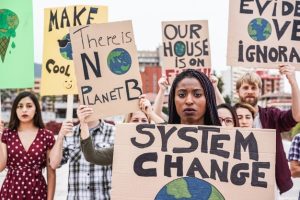Sustainable Living & Sustainable Lifestyle
Negotiations went beyond the end of the summit, but leaders from 200 countries signed a deal that takes a step toward avoiding the worst disasters.
Negotiations went beyond the end of the summit, but leaders from 200 countries signed a deal that takes a step toward avoiding the worst disasters.
When the United Nations COP26 climate change summit in Glasgow, Scotland, reached its end, leaders kept talking. Negotiators kept working beyond the conference deadline and into the next day, hammering out a new climate change deal that may prevent the worst-case environmental disasters.
 The keyword is “may.” Environmental experts said the summit agreement is a positive, but only if countries followed through on commitments made at the meeting.
The keyword is “may.” Environmental experts said the summit agreement is a positive, but only if countries followed through on commitments made at the meeting.
The conference drew protestors from around the world. Many left unsatisfied as the agreement reached at the conference essentially called for countries to develop more detailed plans next year. Many fear leaders are not acting fast enough, including the leaders of some nations.
While the world’s industrial powers play the most important role in making changes that will impact the planet’s future, developing countries made it clear in Glasgow what the agreement will mean to them if the nation’s most powerful countries follow through.
“For us, this is a matter of survival,” Aminath Shauna, a minister in the government of the Maldives, said. “Please do us the courtesy to acknowledge that it does not bring hope to our hearts but serves as yet another conversation where we put our homes on the line, while those who have other options decide how quickly they want to act to save those who don’t.”
The two-week conference started with an easily defined but difficult goal: keep the world from warming more than 1.5 degrees Celsius this century. World leaders established this threshold in the 2015 Paris Agreement.
Experts billed COP26 as humanity’s best, and perhaps last, chance to meet that goal. Most scientists agree that to reach it, countries around the world need to cut greenhouse emissions in half in the next eight years and reach net-zero emissions by 2050. By reaching the 1.5 degrees Celsius goal, the world likely can avoid the worst climate disasters.
However, it won’t be easy. The world’s “leading scientists” already have warned that the world has warmed about 1.1 degrees Celsius above pre-industrial levels, according to CNBC. Without any changes, the latest projections call for a rise of 2.4 degrees Celsius by the end of the century.
For the first time, China and the United States agreed to work together on curbing climate change. While the deal comes with few specifics, just the fact the two countries agreed to address the issue together made for headlines. The two countries are the biggest producers of greenhouse gases.
In the agreed-upon deal, countries signed on to “phase down” the use of “unabated” and “inefficient” fossil fuel. India, a country heavily dependent on coal, insisted on the term “phase down” at the last minute rather than “phase out.” Countries also agreed on reversing deforestation and reducing methane emissions 30% by 2030.
Leaders also agreed for the first time on language that targets fossil fuels subsidies and coal-fired power. However, leaders put off specifics until a later date, with countries asked to develop more detailed plans in 2022. They key is to see if they actually follow through. For a sustainable planet, their action needs to be fast and decisive.